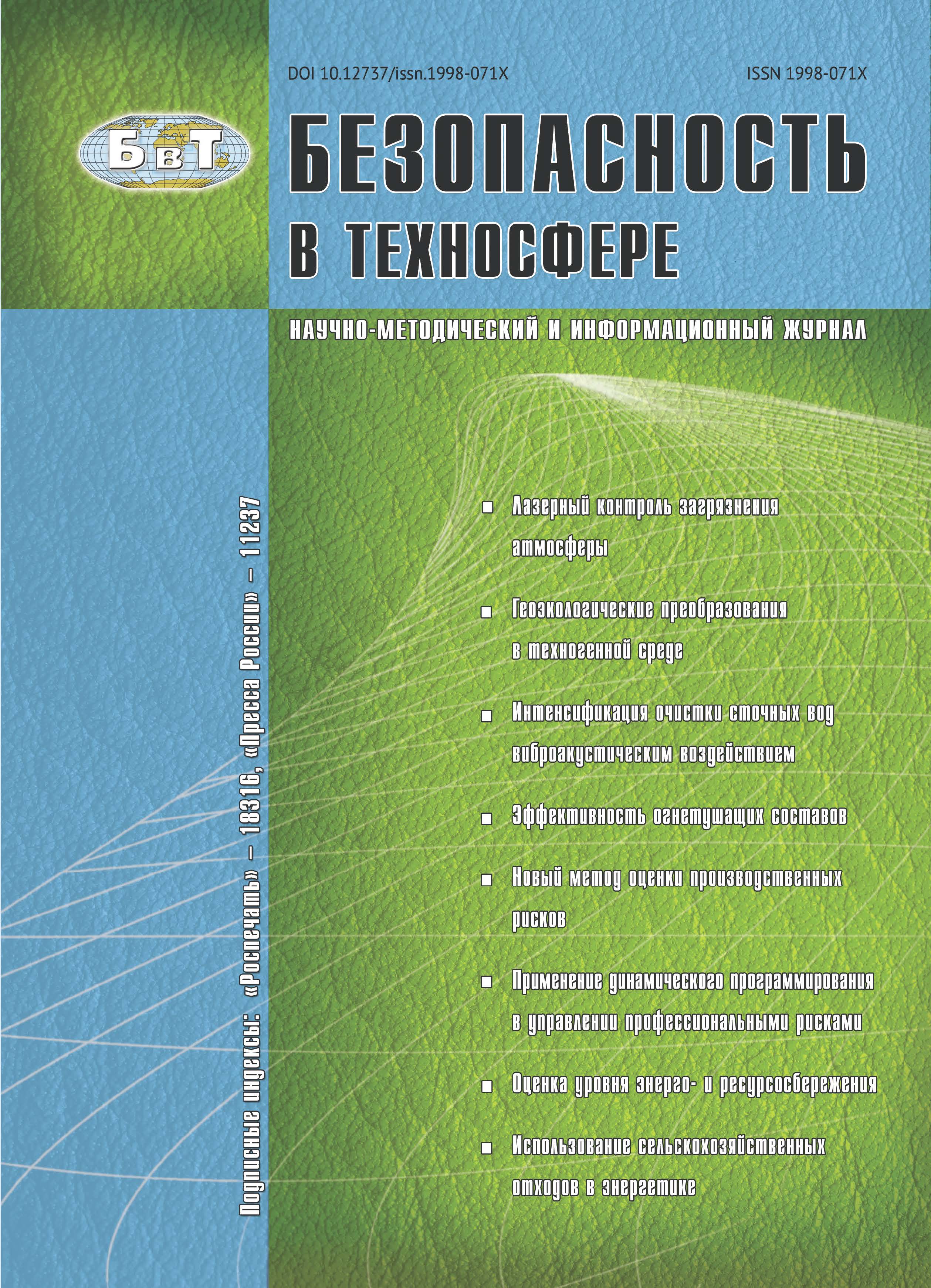Russian Federation
Statistical data for 15 years on emergency situations (ES), fires and accidents on water is provided, and normalized indicators are calculated. During 2000–2014, 8588 disasters were registered in Russia, which killed 14,826 and injured 5 million 841 thousand people. There were 5097 (59,4%) man-made disasters, 2786 (32,4%) natural ESs, 587 (6,8%) biological and social ESs, and 118 (1,4%) major terrorist attacks. Local ESs count up to 4313 (50,2%), municipal — 2977 (34,7%), intermunicipal – 1069 (12,5%), regional — 191 (2,2%), inter-regional — 23 (0,3%), Federal — 12 (0,1%). Every day (1,58 ± 0,15) emergency situations happened which caused death of (2,76 ± 0,25) people. The risk of being in ES (R1) in Russia amounted to (0,40 ± 0,04) · 10–5, the risk of death in an ES was (1,82 ± 0,10) fatalities per year, individual risk of death in ES was (0,70 ± 0,06) 0183 10–5 per year. There is a significant downward trend in these indicators. The lack of continuity of representing even basic ES indicators in State reports "On the state of protection of population and territory of the Russian Federation from emergencies of natural and man-made origin" prevents their comparison.
emergency, disaster, accident, EMECOM of Russia, risks, risk indicators, risk of death, injured.
1. Введение
Чрезвычайная ситуация (ЧС) — обстановка на определенной территории, сложившаяся в результате аварии, опасного природного явления, катастрофы, стихийного или иного бедствия, которые могут повлечь или повлекли за собой человеческие жертвы, ущерб здоровью людей или окружающей среде, значительные материальные потери и нарушение условий жизнедеятельности людей (ст. 1 [1]). По масштабу распространения и причиненному ущербу выделяют локальные, муниципальные, межмуниципальные, региональные, межрегиональные и федеральные ЧС (табл. 1) [2].
ЧС по источнику происхождения могут быть техногенными, природными и биолого-социальными (табл. 2). В отдельную группу ЧС принято выделять террористические акты.
Мерой вероятности возникновения опасного события или явления (ЧС, происшествия или аварии, нанесенного ущерба в социальной и экологической сферах) является риск. Риск определяет возможность реализации конкретной опасности или ее последствий в соответствующих единицах [6].
К сожалению, публикации с количественным анализом показателей ЧС за относительно длительный период времени единичны [7, 8]. Более того, ранние выпуски государственных докладов «О состоянии защиты населения и территорий Российской Федерации от чрезвычайных ситуаций природного и техногенного характера» не рассылались в Книжную палату России и они не представлены в крупных библиотеках страны.
С 2015 г. электронные версии докладов за 2000–2002, 2004 и 2006–2013 гг. можно изучать в удаленном доступе на сайте Научной электронной библиотеки (http://elibrary.ru/query_results.asp). Обобщенные сведения о ЧС также представлены на портале безопасности и анализа риска «iРиск» (http://i-risk.ru/statistics/183/). За 2009–2014 гг. электронные версии государственных докладов размещены на официальном сайте МЧС России (http://www.mchs.gov.ru/).
Цель настоящего исследования — анализ ЧС, возникших в России за 15 лет (2000–2014 гг.), и расчет рискометрических показателей при ЧС.
1. On protection of population and territories from emergency situations of natural and technogenic origin: Feder. Law of 21.12.1994, No 68-FZ, as amended 14.10.2014 г. No 307-FZ. Sobranie zakonodatel´stva Rossiiskoi Federatsii [Coll. of legislation. of Rus. Federation]. 26.12.1994. No 35, Art. 3648; 20.10.2014. No 42, Art. 5615 (in Russian).
2. On classification of emergency situations of natural and technogenic origin: RF Government Resolution of 21.05.2007 No 304, as amended of 17.05.2011 No 376. Sobranie zakonodatel´stva Rossiiskoi Federatsii [Coll. of legislation. of Rus. Federation]. 28.05.2007. No 22, Art. 2640 ; 23.05.2011. No 21, Art. 2971. (in Russian).
3. State Standard R 22.0.05-94. Technological emergencies. Terms and definitions. Moskva. 1995. IV, 12 p. (in Russian).
4. State Standard R 22.0.03-95. Natural emergencies. Terms and definitions. Introduction. Moskva. 1995. IV, 10 p. (in Russian).
5. State Standard R 22.0.04-95. Biology and social emergencies. Terms and definitions. Moskva. 1995. IV, 10 p. (in Russian).
6. Akimov NA., Lesnykh V.V., Radaev N.N. Osnovy analiza i upravleniya riskom v prirodnoi i tekhnogennoi sferakh [Fundamentals of risk analysis and management in natural and technological areas]. Moscow, 2004. 352 p. (in Russian).
7. Evdokimov V.I. Analiz riskov v chrezvychainykh situatsiyakh v Rossii v 2004-2013 gg. [Risk analysis in emergency situations in Russia, 2004-2013]. Saint Petersburg, 2015. 95 p. (in Russian).
8. Knaub R.V. Assessment of energy effects of loss of lives caused by emergency situations in Russia. Tekhnologii tekhnosfernoi bezopasnosti [Technospere safety technologies]. 2013, I. 6. Available at: http://ipb.mos.ru/ttb. (Accessed 14 April 2015). (in Russian).
9. State report on the state of protection of population and territory of the Russian Federation from emergencies of natural and man-made origin in [2000-2014]. Ministry of Emergency Situations of Russia. Moscow, 2000-2015. (in Russian)
10. On the preparation of the annual state report on the state of protection of population and territory of the Russian Federation from natural and man-made disasters: the resolution of the Government of the Russian Federation of 29.04.1995, No 444, as amended of 25.06.2009 No 530. Sobranie zakonodatel´stva Rossiiskoi Federatsii [Coll. of legislation. of Rus. Federation]. 15.05.1995. No 20, Art. 1800; 29.06.2009. No 26, Art. 3204. (in Russian)
11. Criteria of information on emergency situations: addendum to the EMERCOM of Russia оrder dated 24.02.2009 No 92. Byulleten´ normativnykh aktov federal´nykh organov ispolnitel´noi vlasti [Bulletin of normative acts of institutions of the Federal Executive Authorities]. 13.04.2009, No 15. (in Russian)






